Text
Haikyuu light novel vol. 1 translation notes: こぢんまり
Or, “how I got stuck on the SECOND sentence.” smh. Here’s the culprit:
コート1面ぶんのこぢんまりとした第二体育館を使用しているのは、代々、だんしバレー部のみ。
I think the second part/general gist of the sentence is fairly straightforward: For generations, the boys’ volleyball club are the only ones who have used the (...) second gym. It’s all the (...) stuff that comes before “second gym” that’s throwing me off. This might be a case of overthinking, but here I go anyway:
コート1面ぶんの こぢんまり とした 第二体育館
コート1面ぶん is probably “part of a/the court” or maybe just “one side” or even “one court”? I’m not quite sure about the 分・ぶん.
I’ll get to the の in a bit.
こぢんまり is an adverb that means snugly, cosily, compactly. Apparently sometimes the translation is simply “small”. Example:
こじんまりとしたリビング、こじんまりとしたダイニング、こじんまりとしたベッドルーム、それから浴室。
a small living-room, a small dining-room, a small bedroom, and a bath.
But it seems like こぢんまり has more of a “neatly compact, well laid out” sort of feeling to it, rather than just the usual 小さい “small.” See more definitions here.
According to this explanation, とした shows that こぢんまり modifies 第二体育館. And here are a bunch of examples that support this.
PS it took me forever to figure out that you type “di” to get ぢ in the Microsoft Japanese IME. Jeez.
Back to the の: The Japan Times Dictionary of Basic Japanese Grammar has a good list of what A の B can mean. The ones applicable here could be “A is an attribute of B” or “B is made of A” or “A is a specific kind of B.” So it would be something like “the compact second gym with one court.”
Okay. Back to the whole sentence:
For generations, only the boys’ volleyball club has used the small second gym that has just one court.
Or maybe, different wording and flipped around in passive tense:
The compact second gym, which has a single court, has only been used by the boys’ volleyball club for generations.
I’m not too confident about accuracy, but for what it’s worth it seems like others might’ve had trouble with this sentence too.
One translation I found:
For generations, using the court in the tidy gymnasium #2 was, only for, the boy’s volleyball club.
And another:
The second gymnasium could only accommodate a single court, and although small, it was kept clean. For many years, only the male volleyball team would use this gymnasium.
I’m not sure if I’m going to translate the rest of the volume - it seems a little bit above my reading level and I might be better off working on the manga - but from what I’ve seen and read so far the light novels are just so dang cute. It’ll be hard to resist!
1 note
·
View note
Text
調子 (ちょうし、choushi)
Among its many uses, this word appears a lot in games where characters are cheering for you with the phrase その調子. For me this means sports-themed games and rhythm games. In short, it means something like “that’s the way to do it” or “keep it up,” as 調子 can mean “way” or “manner” or “condition.” Here is a nice explanation of how 調子 can be used!
0 notes
Text
Random video game vocab
Trying to translate too much all at once gets overwhelming very quickly, and I think I burned out a bit. So for now I’m picking the title, plus one or two words to learn from the games I’m playing - something that gets repeated over and over.
Games I’ve been playing:
Persona 4(ペルソナ4)
Code: Realize~Guardian of Rebirth~(Code:Realize~創生の姫君)
Hakuoki: Kyoto Winds(薄桜鬼 真改 風ノ章)
Persona 4(ペルソナ4)
真夜中 まよなか
midnight, dead of night
i.e. マヨナカテレビ Midnight Channel (lit. Midnight TV)
Code: Realize~Guardian of Rebirth~(Code:Realize~創生の姫君)
創生 そうせい
creation of the world
姫君 ひめぎみ
young lady/lady (as in nobility), princess
黄昏 たそがれ
dusk, twilight
i.e. Twilight, the organization trying to capture the main character
泥棒 紳士 どろぼう しんし
gentleman thief
i.e. how Lupin describes himself
Hakuoki: Kyoto Winds(薄桜鬼 真改 風ノ章)
薄* うす・ハク
light-colored
桜* さくら・オウ
cherry blossom, cherry tree
鬼 おに・キ
demon
真 しん
real, true
改 かい
revision
風 かぜ
wind
章 しょう
chapter
*the game title uses onyomi readings, but it’s probably more useful to learn the kunyomi for these words
When I googled 薄桜 to see if it was a set phrase/compound word, I found that there’s a movie called 薄桜記 (also pronounced hakuouki, I think). It’s translated as Samurai Vendetta, though, so it seems like the translators abandoned the cherry blossom idea altogether for something that sounds... tougher? More masculine? In contrast, the official translation for 薄桜鬼 is the rather poetic “demon of the fleeting blossom.”
0 notes
Photo
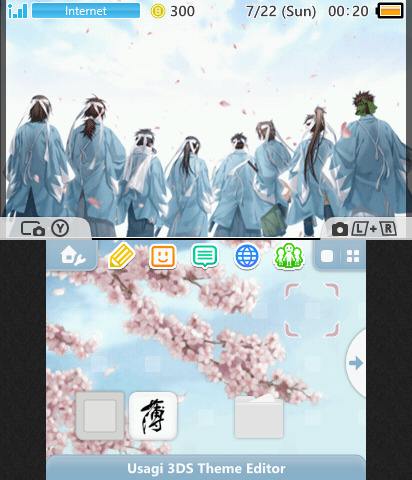

A couple more DS themes I made recently~
3 notes
·
View notes
Text
Nyankoro Talk (にゃんころとーく)
Today we will talk about the cute live wallpaper app Nyankoro Talk!

In this app, you can teach a cat vocab words in several different categories: foods, transportation, activities, people, animals, places, and things. The cat will then wander around your phone home screen and say random stuff based on whatever you taught it.
Here’s an example. I decided to teach my cat the word 掃除する (cleaning, doing chores). You have to answer a few simple questions to help the cat learn the word. For activity-type vocab words, it asks if you like doing the activity and how many people do this activity together. Here you can see that I don’t like cleaning, and that cleaning is something you do alone.
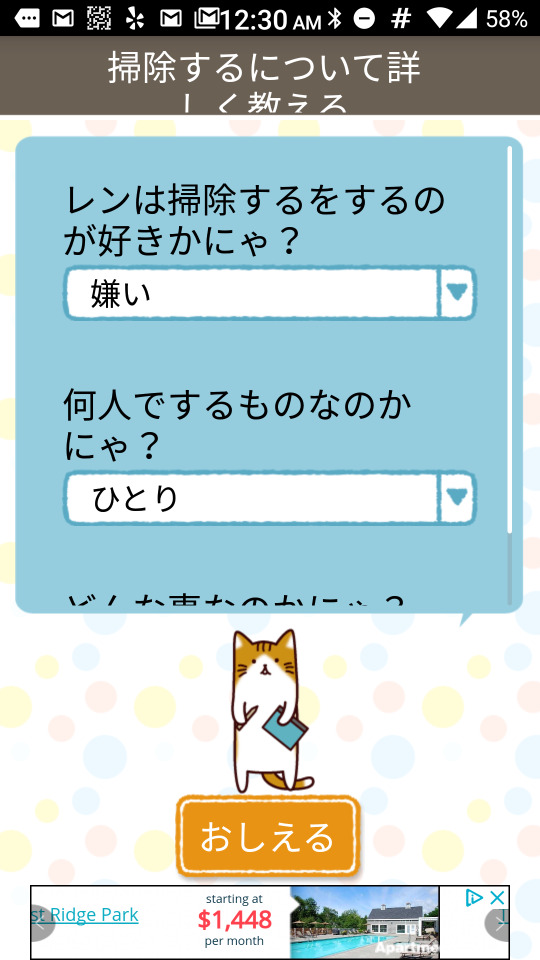
Some time later, I happened to see him say this. I named my cat Pudding (プリン, purin) so here he says “Pudding is not cut out for cleaning, nya.” Me neither, buddy.
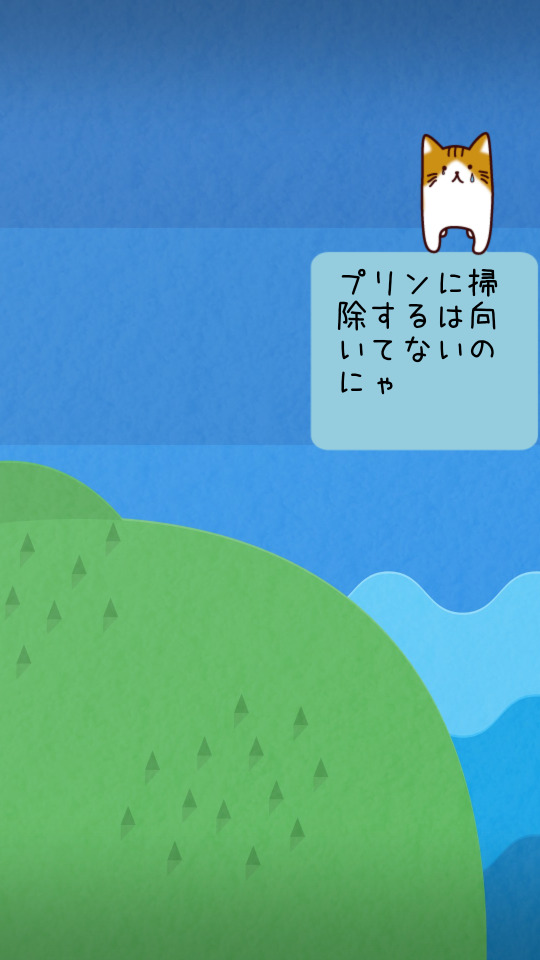
It’s a cute little app that gives you another way to review vocab you’re learning or already know. The sentences are short and sweet, so if you don’t understand the sentence it’s also a good, not-too-time-consuming opportunity for some translation practice. For me the cat’s text bubble disappears rather quickly, so you have to be a pretty fast reader or take lots of screenshots!
Download the app from the Google Play store here.
1 note
·
View note
Text
Some LINE sticker words and phrases
I like “studying” LINE stickers because the whole point of stickers is to represent common words and expressions. Here’s my running list of stuff I’ve learned from my sticker sets:
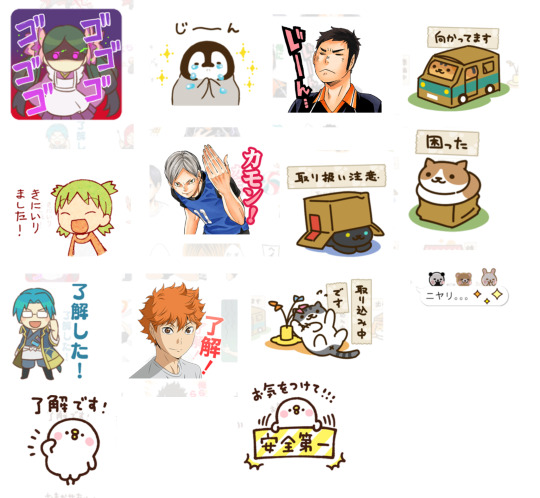
了解・りょうかい Roger that/okay
お気をつけて・ おきをつけて Be careful, take care
安全第一・あんぜんだいいち Safety first
じーん Something that’s touching, moving, heartwarming (usually the sticker has someone sniffing or teary-eyed)
気に入りました・きにいりました I liked it
カモーン Come on (idk why I couldn’t figure out what this was before I saw the Lev sticker)
ゴゴゴ Menacing rumbling
取り扱い注意・とりあつかいちゅうい Handle with care
向かってます・むかってます On my way
取り込み中です・とりこみちゅうです Busy, in the middle of something
困った・こまった In a troubling, uncomfortable, problematic situation
ニャリ Meaningful grin/sneer
6 notes
·
View notes
Photo
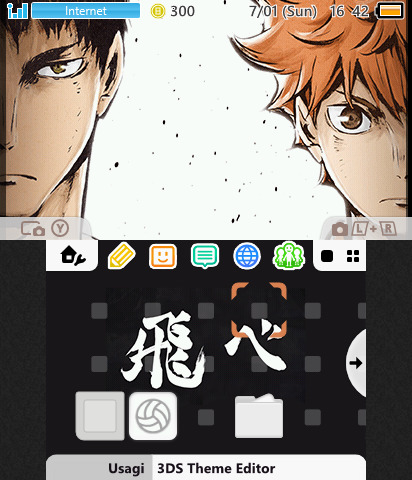

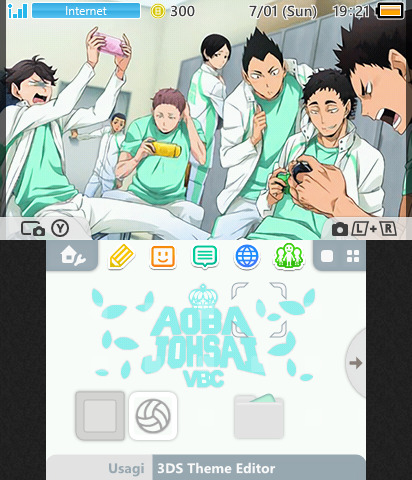
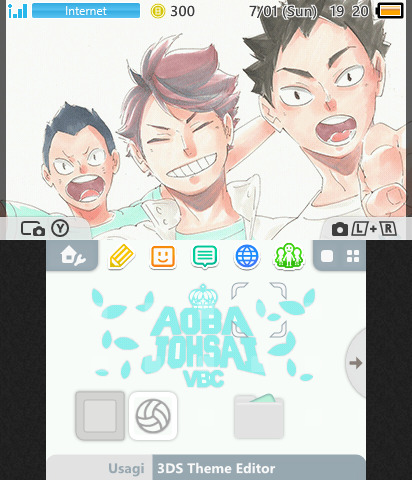
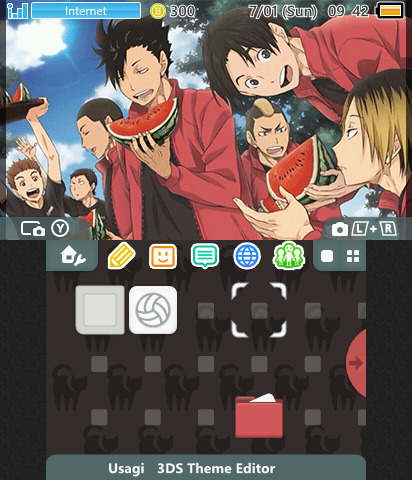
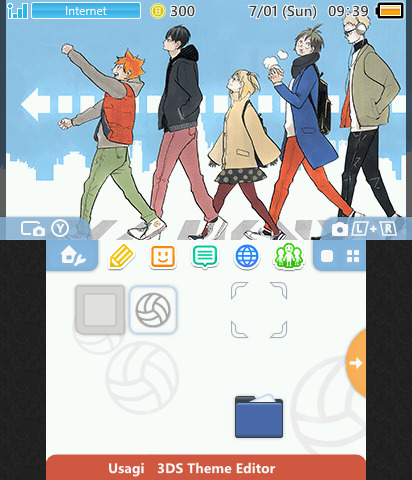
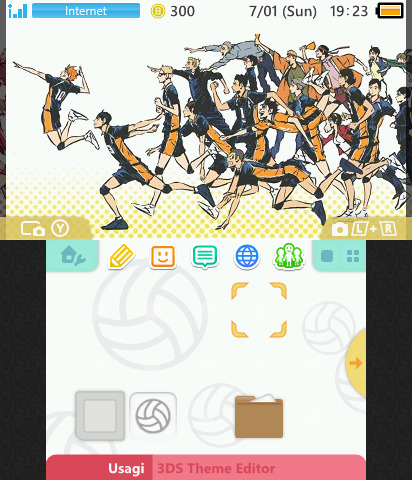
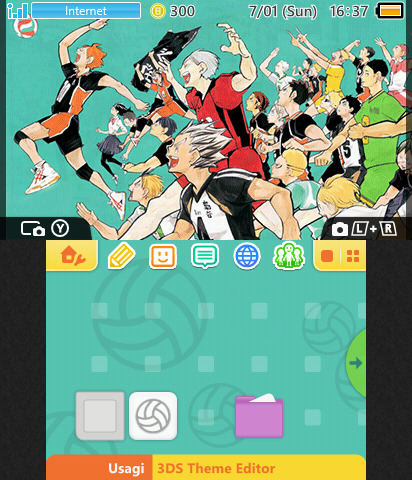
Finally got custom firmware on both of my DSes! The process went perfectly with my US New 3DS, but there was a small mishap with my Japanese 2DS LL and Dragon Quest VIII write errors and I had to wipe my SD card orz
I wasn’t very far in Mother 2 so losing that save was okay, but I lost one of my ACNL villages... spent most of last night and today not doing anything productive making a bunch of Haikyuu themes to make myself feel better ;_;
The first two images are the same theme, but the bottom scrolls between the Karasuno 飛べ banner and Shiratorizawa’s alternate banner 強者であれ. (Pretty pleased with that one!)
#not really about learning japanese#oh well#haikyuu#nintendo 3ds#3ds hacks#anemone#anemone themes#3ds#new 2ds xl#homebrew is so worth it tho
4 notes
·
View notes
Text
Google translate camera, part 2 of 2
Read part 1 of this post here.
Tips for using the camera (and Google translate in general):
1. Translate in chunks
If you have no idea what the translation means, find a subject/topic marker and only translate that part of the sentence. Like this:
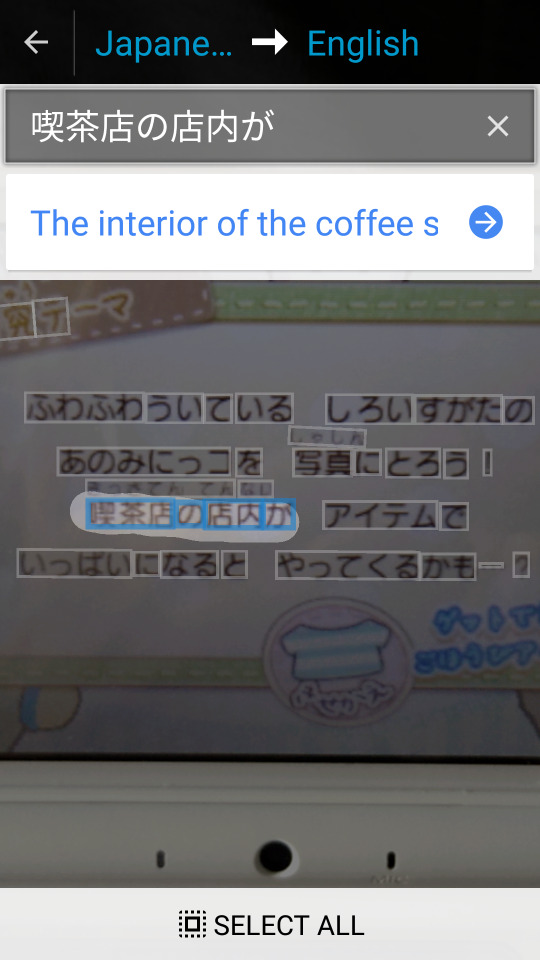
You can also/instead start with the last part of the sentence to see what the verb is.
2. Replace names
Important! Make yourself a list of names and other proper nouns from your game, then either leave them out or replace them with some pronoun(私、君、彼)or a very, very common name before translating.
Take the game in this screenshot/the last post. The little creatures in the game are collectively called すみっコぐらし sumikko gurashi, aka 隅っこ (corner, nook) plus 暮らし(life, living).

They’re basically cute animals and food items that like huddling in corners. But here is what you get when you enter various forms of すみっコぐらし into Google translate:
すみっコぐらし or sumikkogurashi = “pleasure calling”
sumikko gurashi = “Sumire Crying”
すみっこ or sumikko = “corner,” which is right, but
ぐらし、くらし、gurashi, or kurashi = gouge
Soooo yeah. You can see how some of these would totally mess up a translation attempt.
3. Don’t use it to translate
Treat the Google translate camera like an OCR app and use it to get the text into your phone without having to type kana or write. And then you can copy paste words into a dictionary app!
That’s it for this post. I’ll probably write a game recommendation post about this Sumikko Gurashi game if only to post some adorable screenshots ( ̄▽ ̄人)
0 notes
Text
Google translate camera, part 1 of 2
I feel like a lot of people hate on Google translate, and I get it. I mean...
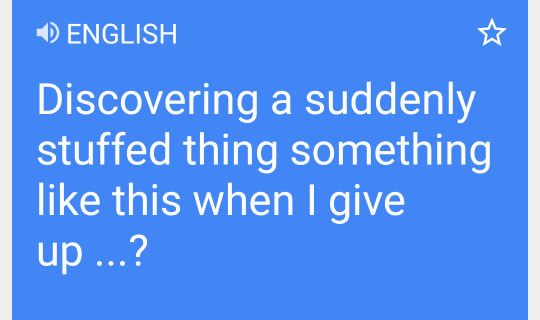
But this doesn’t mean you should never use it! Let’s look at the Google translate app’s camera feature in the context of playing video games.
Let’s say you’re playing a game with no furigana. When you come across kanji you don’t know, you really only have three options for looking it up in a dictionary:
handwriting input
search by radicals
Google translate
Handwriting input is fine, but it’s time consuming. I don’t have the patience for looking something up by radicals, and since I haven’t done it since elementary school in Taiwan over 20 years ago I usually forget it’s something you can do. Method 3 is today’s topic: the camera function on the Google translate app.
I haven’t tried any of this on iOS, sorry! Here’s a very Android-oriented set of instructions and screenshots.
So all you need is the Google translate app. Tap on the camera icon...
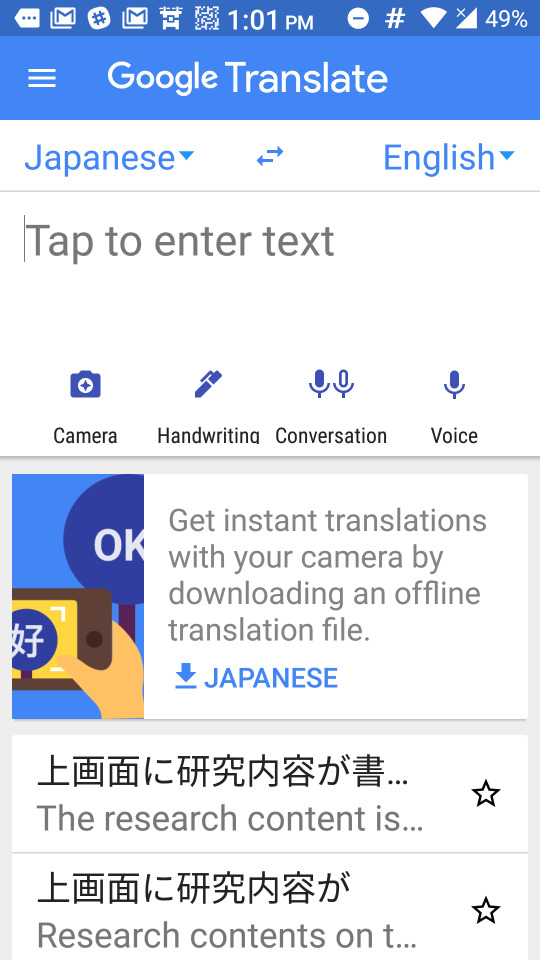

Of course, you need legible text for the app to pick up the words. Computer/TV gaming is fine, but for handheld I almost never play on my phone. I play on a 2DS XL, a tablet, or an emulator to get the biggest possible display size. And then my phone does the translating.
The app is surprisingly good at picking up some hard-to-read text.

This was actually translated pretty well, despite the font.

And then you select what you want it to translated. Make sure you don’t include the furigana if there is any! (I probably would’ve just used a dictionary for this because there’s furigana, but I just got this game today and wanted to play it haha)
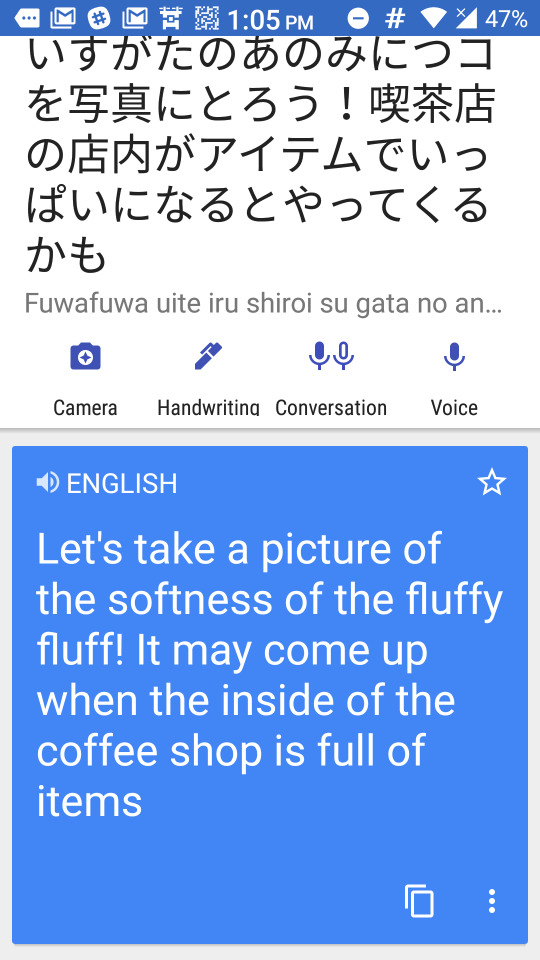
And here’s the translation. This is supposed to be a hint for one of the achievements in the game, and and I think this is good enough for figuring out what you’re supposed to do.
You need an internet connection to do this. There is an option to download the whole dictionary so that you can translate offline, but I can’t get it to work for some reason ¯\_(ツ)_/¯
A few tips for using this in the next post!
* The sentence is from one of the Sumikko Gurashi games (おみせはじめるんです) for 3DS and the screencap with the white, squished font is from the Haikyuu mobile game ドンピシャマッチ.
0 notes
Text
押忍!闘え!応援団 (Osu! Fight! Ouendan)
This is a rhythm game for Nintendo DS.
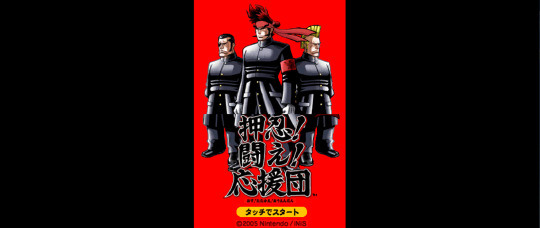
First of all, ouendan (応援団 おうえんだん) is a type of cheerleading group which is best explained by video rather than words. In the game, you’re part of an ouendan squad who goes all over the city to cheer for people in need.
There are two difficulty levels, one where you play as the squad leader and an easier one where you’re a new member.

Here’s the leader, Ippongi Ryuuta. I thought he was wearing some kind of microphone headset until I realized those are his sideburns.
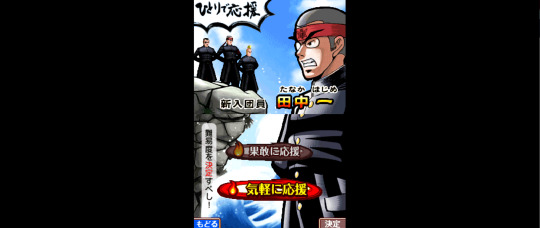
And the new guy, Tanaka Hajime.
I only played the first stage, where a guy is trying to study for his university entrance exams but his family is being loud and annoying.
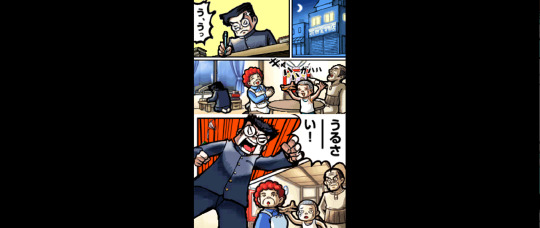
Here the family is laughing (the sound effects are kyahaha and gahaha) and the guy yells urusai! which can be translated as “annoying!” or “shut up!”

The family totally ignores him (しらんぷり). So he screams “ouendaaaaan!”

The squad shows up, and it turns into a rhythm game like the PC game Osu! where you tap or drag the stylus in time with the music.
As they cheer, the family becomes more supportive. I didn’t take screenshots because I was playing, but I think at one point the mom makes him katsudon (fried pork cutlet over rice) which you eat before a competition or test or whatever because katsu 勝つ also means "to win.” The dad quietly watches him from the hallway, looking all proud and such (he says/thinks something but I didn’t catch it.)
There’s not a lot of text in this game, so translating it is very doable. Unless you’re me and can’t take a screenshot while playing without failing the stage;; Fortunately, someone translated all the comic panels from this game and made a guide on GameFAQs, so if you ever play this game then check that out!
PS. The manga Again!! is about a guy who’s thrown back in time to relive high school, where he inadvertently joins the school’s failing ouendan squad. It’s written by Kuro Mitsuro, better known as the writer for Yuri on Ice!!!. A fun read, plus the official English edition of the first volume (maybe two?) came out earlier this year.
0 notes
Text
ポケモンカードゲーム あそびかたDS (”How to play the Pokemon Card Game DS)

This isn’t exactly a game, but it’s really good Japanese reading practice so I thought I’d post about it anyway.
ポケモンカードゲーム あそびかたDS (”How to play the Pokemon Card Game DS) is a tutorial/reference type of game for Nintendo DS. Well, it’s not actually a game because you can’t play the Pokemon card game with this. It’s something you would keep next to you when you plan the physical card game to look up rules and stuff.
Still, the part that I find most useful (for Japanese, not for playing the Pokemon card game!) is the tutorial (あそびかたをおぼえる, learn how to play) section.
It’s presented as a conversation between two kids, where the boy Shun (シュン) collects Pokemon cards but doesn’t know you can use them to play a game. His friend Nanami (ナナミ), who does know, shows up and decides to give him a rundown of the rules (while he tries to hide the fact that he doesn’t know anything).
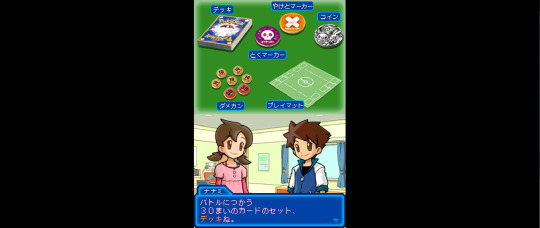
The conversation is easy to read - all kana, and verbs you probably know if you’ve started learning Japanese verbs:
おぼえる to remember/learn
おしえる to teach
��る to take, to pick up
あう to meet
(If you’re into shonen manga you might know words like たたかう to battle and たおす to defeat).
For me this was an exercise in recognizing verb forms other than the very-recognizable て or ます or negative or past tense forms. Like I’ll see causative and think it’s a different verb until the dictionary says otherwise;;; but understanding the rest of the sentence makes it easier to figure out what the verb is supposed to be.
Non-verb vocab wasn’t too bad, either. There were some adverbs I didn’t know, and slightly uncommon words like おさななじみ (childhood friend) but the sentences are straightforward. Have you ever looked up every word in a sentence and still don’t know what the hell it means? There might’ve been one or two of those for me in the first conversation/part of the tutorial. But in general the sentences are like “my brother is busy” or “this card is cool” which I think is very readable.
As an added bonus, if you ever plan on playing Pokemon in Japanese, it’s good katakana practice for words you’ll probably see over and over again:
ポケモン Pokemon
バトル battle
トレーナー trainer
マスター master
スキル skill
It’s too bad you can’t actually play the card game in this game, and the last time I had physical Pokemon cards was like 20 years ago (hah) but all-kana reading isn’t easy to find in games and, game or not, this is a nice example.
PS The DS is the only console I can think of with not-really-a-game games like this - notably the My (Language) Coach series and this very well-reviewed Japanese dictionary that supports handwriting input.
PPS. I play DS games on my computer with an emulator. Google to find games for it!
0 notes
Link
Square RPGs plus Mother 2 and 3 Japanese scripts.
Found this list because I started replaying FFIX (in English) and was curious about some of the character names in Japanese. The FFIX one specifically is really, really good because it’s Japanese/English side-by-side, with translator commentary.
#resources#games in japanese#learning japanese#jrpgs#final fantasy#chrono trigger#mother 2#mother 3#dragon quest#translated games
1 note
·
View note
Text
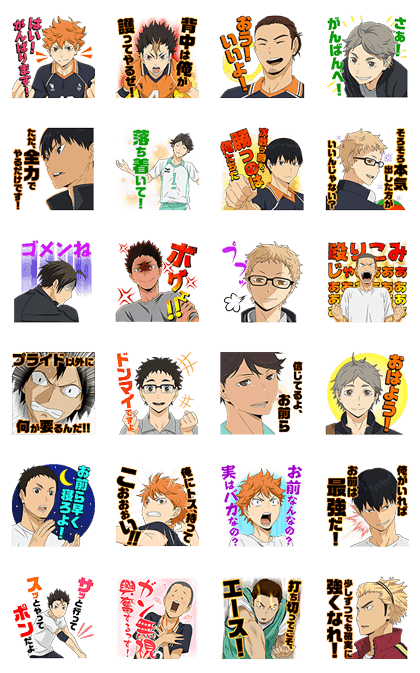
Downloading Japan-only apps and stuff is always a giant pain. To this day I have no idea how I managed to download DPM on my regular Google account... But! I finally got the Haikyuu LINE stickers (ALL OF THEM yassss) after reading this on Reddit.
I never even thought about making a new account and gifting the stickers to myself until reading that post, but it works perfectly. The only two downsides were 1) I needed to make the account on a separate physical device, emulator didn’t work and 2) having to make a fake facebook account because facebook makes you give your real phone number... even though the point of fb login is not entering your number anywhere. But anyway it works! I look forward to spamming chats with these <3
#not really about learning Japanese#but you'd be surprised at how much vocab you learn from stickers#LINE#haikyuu
0 notes
Text
A few ways to find definitions and explanations for Japanese phrases online
Dictionaries go a long way in learning any language, but they fall short when it comes to phrases or grammar or a definition that just doesn’t make sense in the context you’re reading it in. Here’s how I search for these:
I know I just said dictionaries don’t work, but look it up anyway. The phrase might be common enough to have its own entry.
English - Japanese dictionaries (jisho.org, Akebi, takoboto)
Japanese-only dictionaries (Weblio, goo)
Google search:
Phrase by itself
Phrase plus the word 英語
Phrase plus the word 意味
Phrase plus the word “usage”
Start typing the phrase and see what suggestions come up (both in Google and in the IME or app keyboard you’re using)
An Chrome/Firefox extension like Yomichan or Rikaichan is a must for most of these search methods; you can hover over any Japanese word and it’ll show you a popup with dictionary definitions. Google translate is also handy but you have to copy and paste :3 also it’s tempting to paste an entire sentence or entire paragraph in there, but the translation it gives you can be weird or even misleading
Buuuut if I’m playing a game on my phone or 3DS without furigana I do use Google translate’s camera feature
There are also some sites that I always read if they come up in a search result, or I’ll browse through them when I get bored. For some reason I always forget to look things up directly on these sites though...
Japanese Stack Exchange
Maggie Sensei
Any site where Japanese speakers are asking for natural-sounding English translations
Tae Kim’s guide sometimes
If I’m really stuck on grammar / for random physical book reading I go to A Dictionary of Basic Japanese Grammar or Japanese the Manga Way (btw I was not expecting much from this book but it’s really, really good).
1 note
·
View note
Text
Fairs(フェア)in Manpuku 3 (and 2)
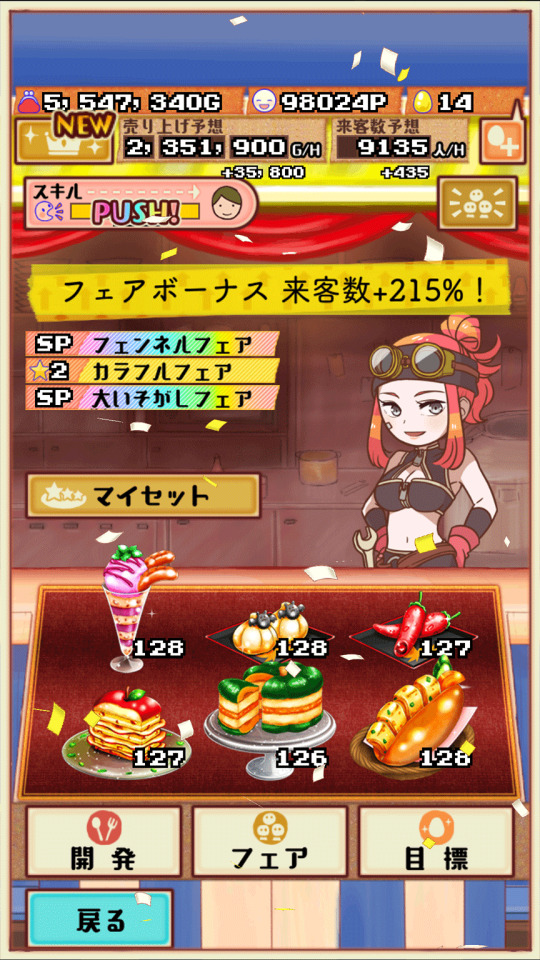
Welcome to another Manpuku Marche 3 guide! The topic this time is the fair (フェア), which in this game is another name for special combinations of dishes. More info on reddit here. In this example we will see how to get this 215% bonus increase in customers using fairs.
PS. this guide should work for Manpuku 2 if you ignore everything about locations and location-based bonuses.
Here we go~

Here’s a breakdown of our end result. We’ll go step by step through this, starting with the popular fairs memo.
Displaying any fair at all gives you a minimum 10% bonus in the number of customers who come to the kitchen car, all the way up to 70%. But every village has a minimum of two special, extra-popular fairs that get an even better bonus. The biggest bonus you can get by displaying a single fair is 140%.
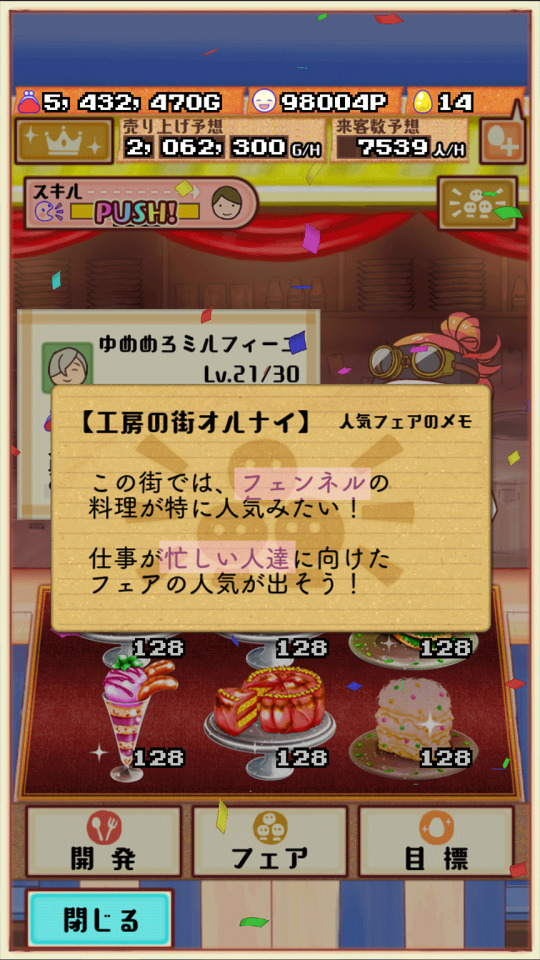
This is the memo that tells you about two fairs are popular in this village. At the beginning of the game you’ll just have a bunch of ???s in place of text. This is because you unlock these memos by hanging out with each of the chefs and supports. That doesn’t really matter if you’re using a guide, though, because the memos are just a hint and not required for you to set up a fair.
But let’s see what’s going on with this memo anyway. This example takes place in Orunai(オルナイ), and the two popular fairs are Fennel’s fair and the busy person’s fair. So let’s try and display these by first tapping the フェア button at bottom center.

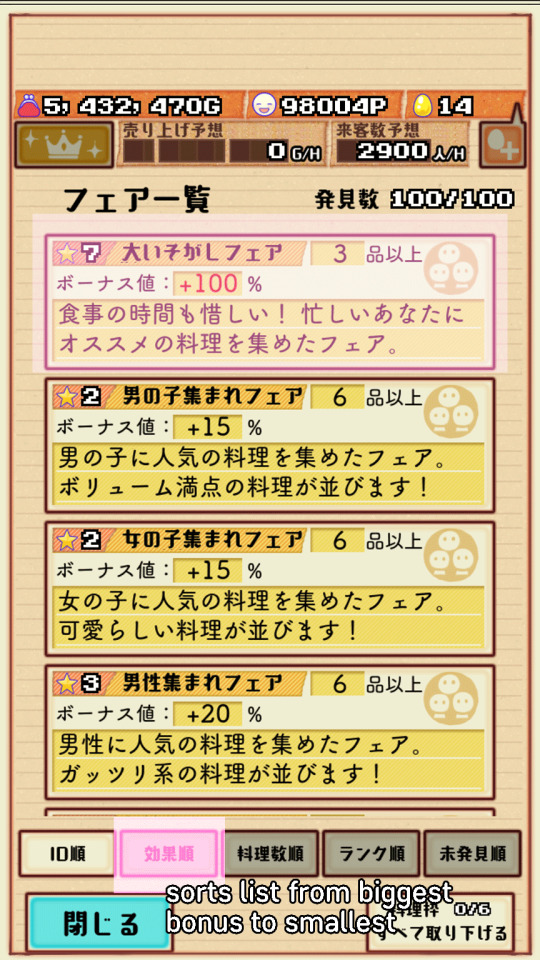
This is the fairs list. The bonus for any special fairs will be in red, like Fennel’s is two screenshots ago and the busy person’s fair is in the one right above. Hint! Use that second button to sort all the fairs in descending bonus order.
We’ll start with the busy person’s fair, so tap on that and you get:
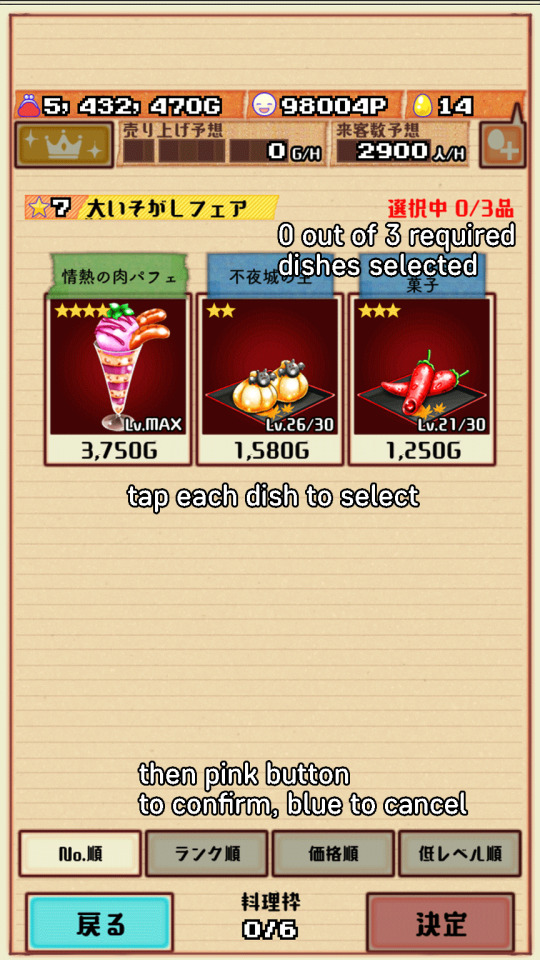
Sometimes there will be more dishes listed here than you need to display. Like if there were 8 dishes on this screen, you can pick any 3 you want. Try to pick the dishes that overlap with other fair bonuses! We will be doing this in a moment.

Yay! The busy person’s fair is now on display. We have 3 slots left, so let’s try to put another one up at the same time.
We know that Fennel’s fair is also popular in this town, and that it requires any 3 dishes made by Fennel. We can fill the remaining 3 slots with his dishes, but the pink hotdog parfait thing is already one of his. So we just need to pick 2 more that he made.
You can tell who made what dish by the dish name’s background color. The chefs’ colors are:
Yukari - pink
Fennel - green
Marjoram - yellow
Bouquet Garni - red
Mitsuba - purple
Rindo - blue
Two screenshots ago we can see that the hotdog parfait is made by Fennel, while the other two are made by Rindo.
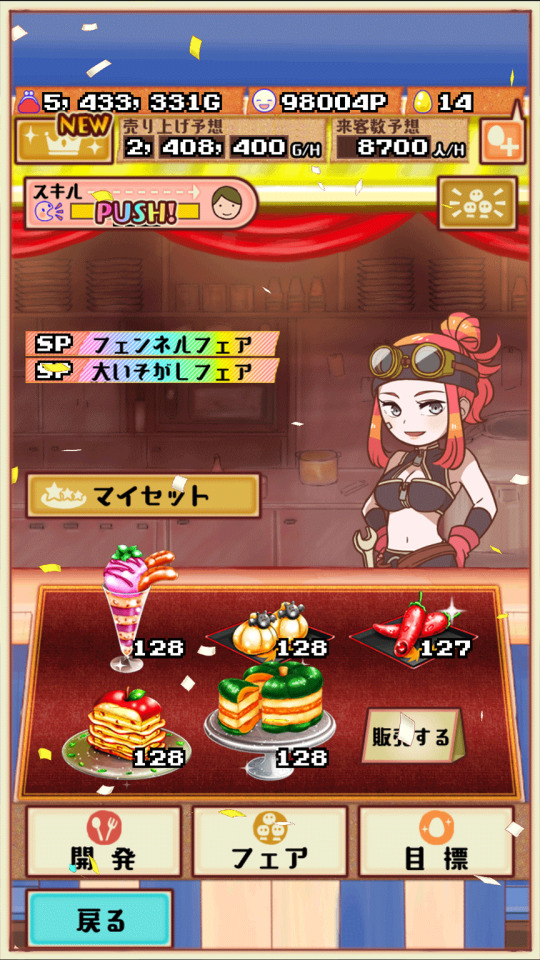
Anyway, I picked the apple millefeuille and pumpkin cake as the two other Fennel dishes. Now there are two special fairs on display.
We can probably squeeze one more fair in here. So tap the unoccupied spot on the table to pull up the list of dishes.
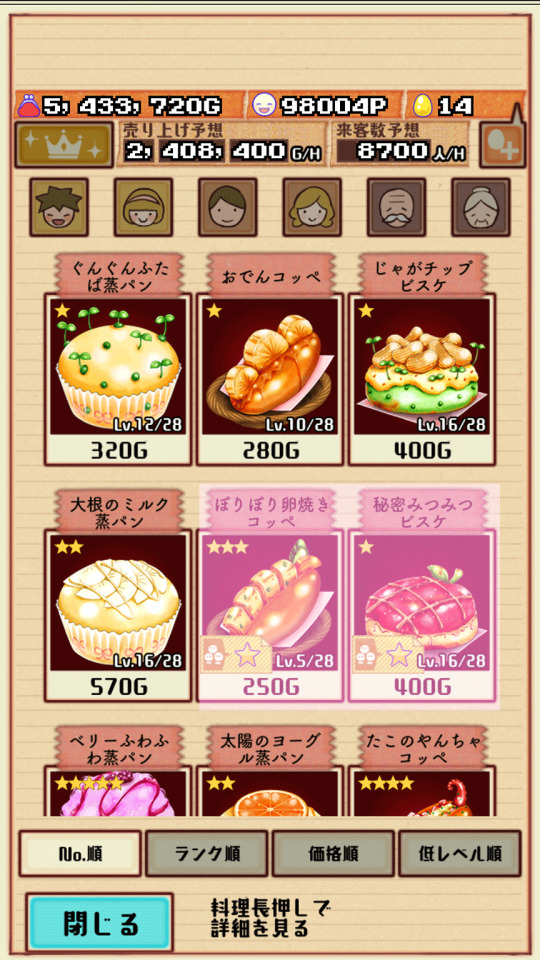
Dishes that have a star in the bottom left corner are ones that will complete a fair if you select them. I picked the 250G bread near the middle of the screen.

And here we are with a 215% bonus! By adding that bread, the Colorful fair is now on display too.
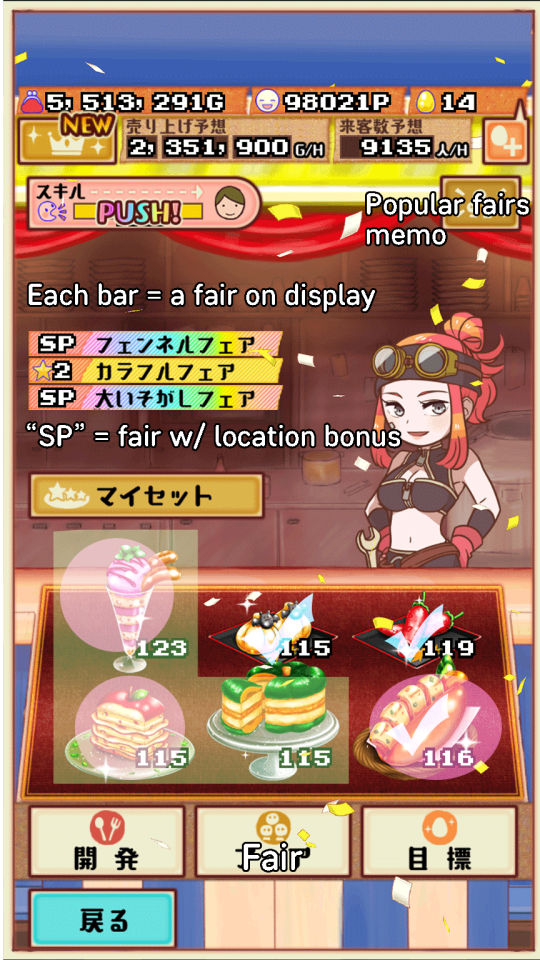
Hopefully this screen makes more sense to you now. The dishes inside the L shape are from Fennel’s fair, the circled ones are from the Colorful fair, and the checkmark ones are from The busy person’s fair.
So this is how fairs work! Manpuku 2 is pretty much the same, but without the memos and the location bonuses. I have lists of fairs and locations that I’m working on here and here so check those out soon!
A few hints to wrap this up:
Every chef has a fair that consists of any 3 dishes they make.
The following chef/village combinations give a 100% bonus:
Yukari: ルイラニ
Fennel: オルナイ
Marjoram:レヴン
Bouquet Garni: ウリロベ
Mitsuba: デシカ
Rindo: カムイ
Try combinations of dishes with similar visual characteristics. For example, dishes that are the same color, or presented the same way (eg wrapped in foil), or have the same ingredient (though sometimes this isn’t obvious).
If there is an exclamation point instead of a star in the lower left corner (see 3 screenshots ago) of a dish, it will complete a fair you haven’t discovered yet!
0 notes
Text
桃栗堂
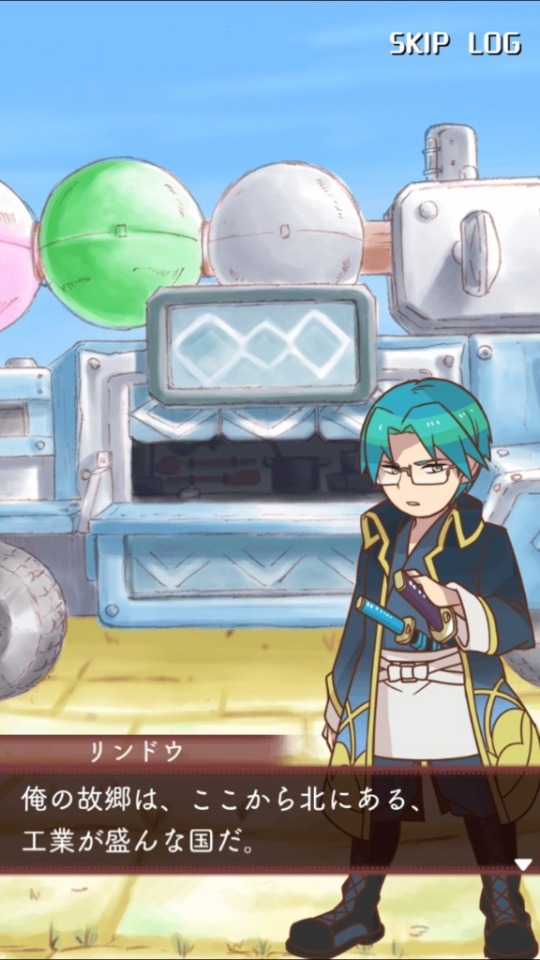
Today’s Manpuku investigation is Rindo who, despite appearances, runs a wagashi shop: 桃栗堂三点店. The individual kanji are pretty common and straightforward, there’s peach, chestnut, hall (as in meeting hall)/shrine, three, point, store. But is there a reason for this specific name...?
The goal is to try and translate 桃栗 to something other than Momokuri, like Mitsuba’s Crescent Moon 三日月亭. There is the reasonable opinion (fact?) of “sometimes names just need to sound and look nice,” and I do like the sound of Momokuri, but 1) I haven’t been sleeping enough to be reasonable and 2) after watching Haikyuu I need to find subtext/meaning in every single fictional name.
So here we go with 桃栗堂三点店.
A few dictionaries offered 桃栗三年柿八年 as a suggestion for 桃栗 . (Literally it’s peach, chestnut, 3 years, persimmon, 8 years). It’s a saying that means (quoting jisho.org) “it often takes time to bear the fruit of one's actions”. Seems appropriate for a very traditional, artisanal business.
Then I actually read more of his story, and at one point they visit the original 桃栗堂 where Rindo was trained. So 三点店 probably means it’s the third store.
Mystery solved!
I mean, this is a good conclusion. I’m seriously considering deleting the rest of this post. But in honor of rabbit holes everywhere, here’s some more research.
This time, I added the word wagashi 和菓子 to my searches. There is a wagashi shop irl called 桃林堂, and their names of course look very similar. But here it’s not just 桃 and 林 next to each other like 桃栗 seems to be, because 桃林 とうりん means peach grove. Still, a real shop with this name supports the idea that Rindo’s shop was named for wagashi-related reasons.
For the search term 桃栗 和菓子 I got results for a confection (is that the right word?) called 桃栗しぐれ. So it’s actually a type of wagashi! But they were all Amazon or Rakuten etc. listings of stuff in plastic bags so it’s probably a modern thing. However it seems to be a combination of 桃山 and 栗しぐれ, two traditional and apparently similar-tasting examples of wagashi.
This is 桃山:

And here is 栗しぐれ:
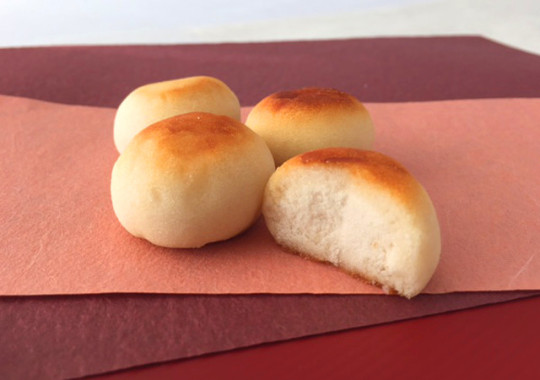
Images from here and here.
Apparently 桃山 is named after a place in Kyoto, and the しぐれ part of 栗しぐれ is 時雨 late autumn/early winter rain. (Reference here.) So 栗しぐれ is supposed to resemble raindrops. If you put them together it feels like the setting of a poem or something.
This is way off track from 桃栗堂. But it was a fun tangent and, as a result of all of this... I didn’t know the word 栗 before, but I sure do now _(:3」∠)_
0 notes
Photo

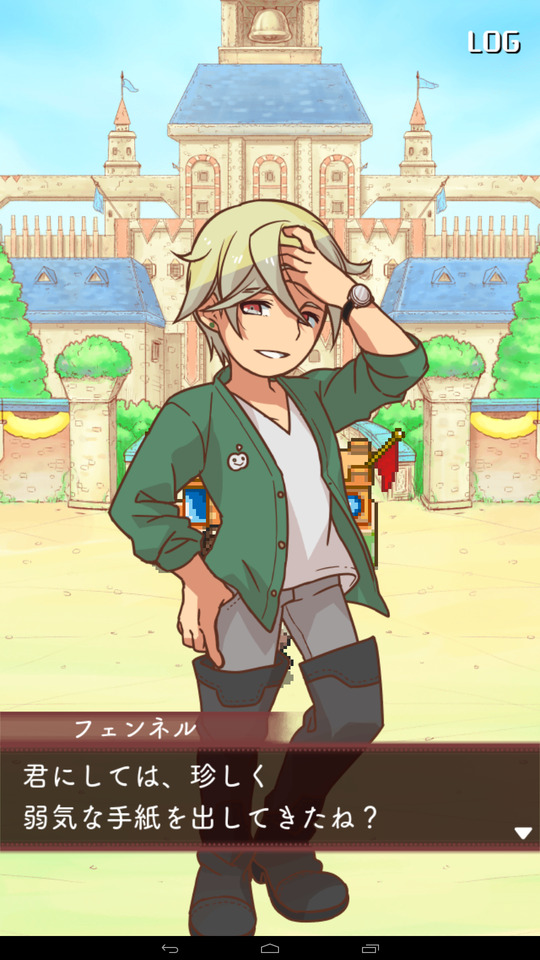
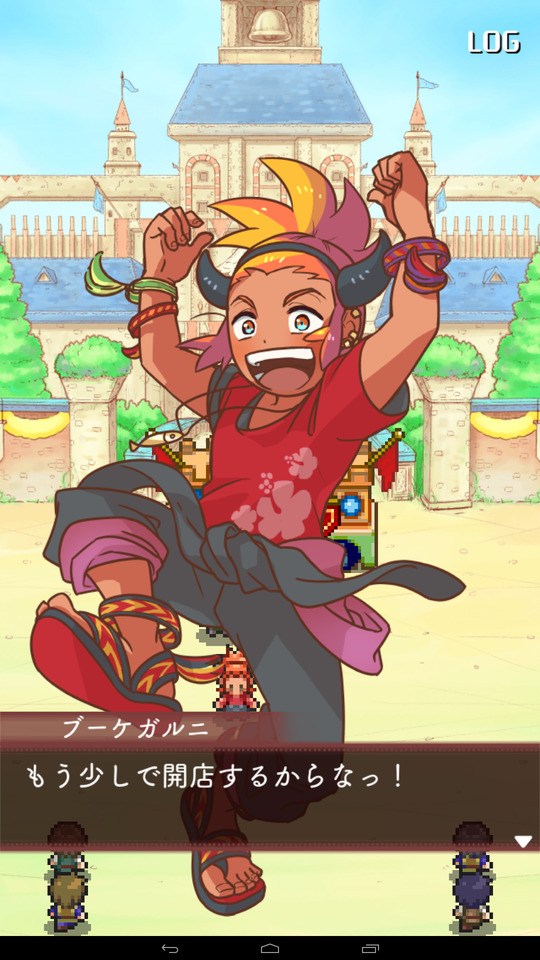
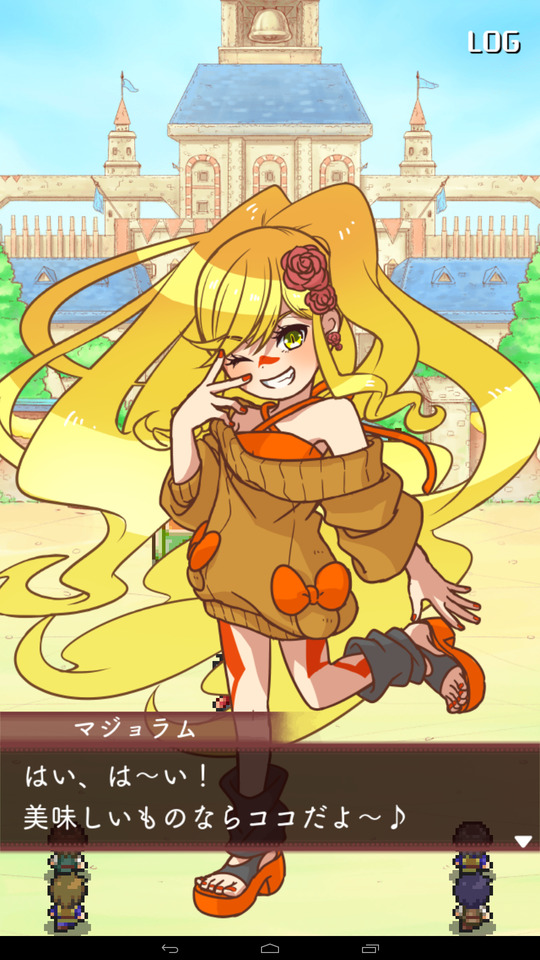
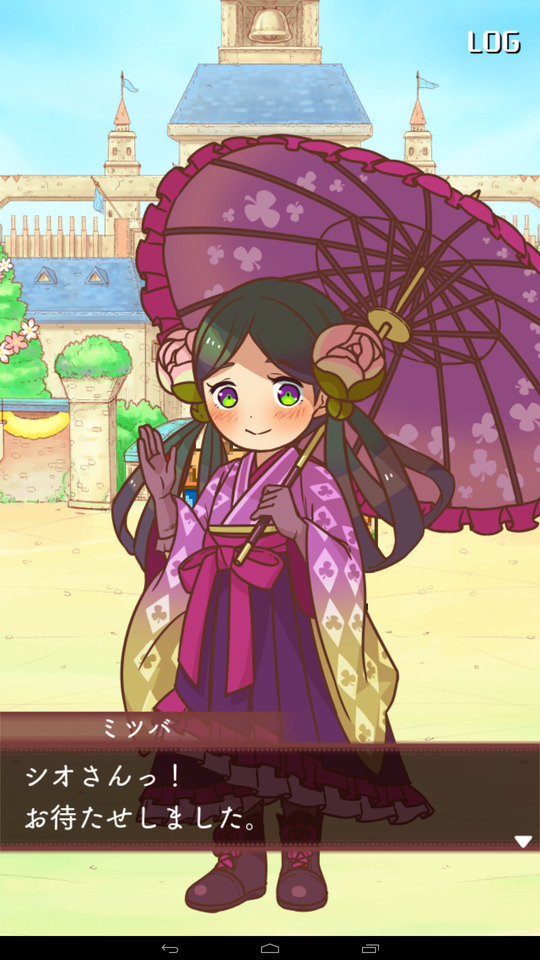
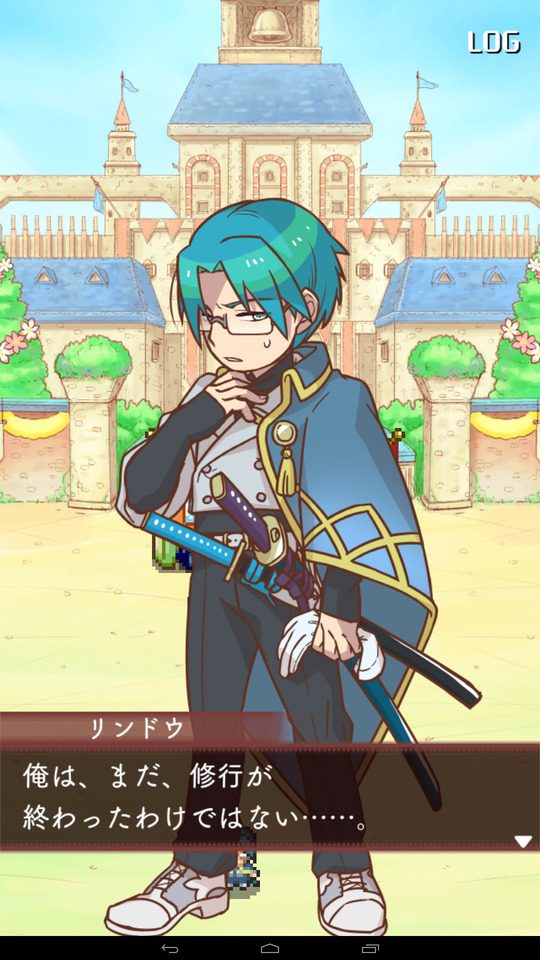
Chefs in casual outfits! I think this is each of their first lines in Manpuku 2. On a completely not-educational note, A+ to Rindo for wearing practical shoes with that very official getup and a “geh are you serious” to Fennel for over-the-knee boots. Really?
I started hearing Marjoram’s dialogue in Tanaka Saeko’s voice and now I love her (both of them Saeko-neesannn) even more.

#manpuku marche#i'm definitely gonna flood that tag#video games#anime#not really about learning Japanese#oh well
1 note
·
View note